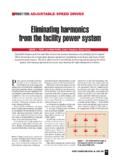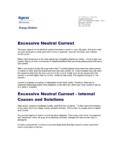Transcription of Power Quality Issues, Impacts, and Mitigation for ...
1 Power Quality Issues, Impacts, and Mitigation for industrial Customers By Kevin Olikara, Power and Energy Management Products Rockwell Automation, Inc. Now, more than ever, electronic equipment and computing devices are used in all types of industrial processes. This has been pivotal in making these processes more productive, efficient, and safe. However, this trend also makes manufacturing processes and equipment more vulnerable to real-world Power Quality conditions. Power Quality is related to fluctuations in the electrical supply in the form of momentary interruptions, voltage sags or swells, transients, harmonic distortion, electrical noise, and flickering lights, among others. The electrical Power grid is designed for delivering Power reliably, namely maximizing Power availability to customers.
2 However, Power Quality events are largely untracked, and as a result, can take out a process as many as 20 to 30 times a year, costing industrial customers millions of dollars. To minimize these costs, it is critical for industrial customers to understand how Power Quality is impacting their system and how to mitigate its effects. 2 | Power Quality Issues, Impacts, and Mitigation for industrial Customers industrial customers are becoming more aware of the direct costs Costs show up in the associated with the electrical energy consumed by their machines and processes as it shows up every month on their utility bill. However, the form up plant downtime, indirect costs associated with poor Power Quality , or voltage Quality to lost work in process, be more precise, while just as significant, are less obvious.
3 These costs additional labor, and show up in the forms of plant downtime, equipment replacement, lost work in process, additional labor, and possibly missed shipment dates. possibly missed Without the ability to monitor and gain a comprehensive shipment dates. understanding of the impact Power Quality has on industrial processes, these costs will continue to go unaddressed. However, with the knowledge to identify and mitigate Power Quality events, process reliability can be significantly improved. The utility is responsible for the reliability of Power , not the Quality of Power . The supplied Power by the utility generally does not have an ideal sinusoidal voltage, and the customer is responsible for protecting their sensitive equipment at their own expensive.
4 Moreover, the electrical equipment and machinery within the plant floor can worsen the Quality of Power being distributed. There are numerous types of Power Quality problems; however, the three types that impact industrial customers the most are voltage sags, harmonics , and transients. Sags Voltage sags are an RMS voltage reduction by at least 10% of the nominal voltage that lasts between half a cycle and a minute. IEEE 1159, Recommended Practice for Monitoring Electric Power Quality , classifies sags as instantaneous ( cycles to 30 cycles), momentary (30 cycles to 3 seconds), and temporary (>3 seconds to 1 minute). In a study done by the Electric Power Research Institute (EPRI), an average of 66 voltage sags was experienced by industrial customers per year.
5 Example 60% sag with What are the causes and effects of sags? a duration of 4 cycles (Instantaneous) A common cause of sags for industrial customers is turning on large loads such as large motors. If using an across-the-line motor starter, the current draw when turning on a motor can be six times or more of its normal running current. The large and sudden current draw results in downstream voltage drops. Weather factors, such as lightning, wind, and ice, are also significant 3 | Power Quality Issues, Impacts, and Mitigation for industrial Customers contributors to voltage sags. From an electric utility perspective, a fault on the transmission system can produce a sag to electricity users downstream of that location, and depending on the system topology, users upstream or even on connected distribution circuits can be affected as well.
6 Depending on the ride through capability of a variable frequency drive, a sag can create an undervoltage condition on a drive's DC bus, tripping the drive and potentially stopping critical process lines. Often times, process controls use 120 VAC relays in the emergency stop circuit of control circuits. Sags can contribute up to 20 shutdowns a year by tripping these relays. Programmable logic controllers (PLC) and other industrial computers can be very susceptible to voltage sags. All computing equipment requires a Power supply to provide a low DC voltage in order to operate. Without sufficient ride through capability, computing equipment can be disrupted during sags, severely impacting industrial controls and causing data corruption. Moreover, if using digital I/O, a logical high can be read by the PLC as a logical low if the input voltage drops significantly, potentially causing process disruption.
7 How do I mitigate sags? Uninterruptible Power Supplies (UPS) is the most common solution for all types of RMS voltage variations (sags, swells, undervoltages, overvoltages, and interruptions). A UPS uses stored energy in a battery to provide load Power when the normal Power supply falls outside a defined voltage range. If the sags a customer is experiencing are largely in the instantaneous or momentary classification, an alternative to a UPS is an Electronic Sag Compensator. An electronic sag compensator uss a capacitor instead of a battery for energy storage. As a result, electronic sag compensators are lower maintenance and have higher rated lifetimes. In addition, electronic sag compensators are generally more lightweight. However, electronic sag compensators don't have the same ride-through capability as a UPS for longer duration sags.
8 Voltage sags can also be addressed by using constant voltage transformers (CVT), which are generally suited for constant, low Power loads. By saturating the transformer core with magnetic flux, differing from most transformer applications, a relatively constant output voltage is maintained. Sags that result from the starting of large motor loads can be addressed by using drives or soft starters to minimize in-rush current at start-up. harmonics harmonics are a form of voltage or current waveform distortion. A harmonic refers to a component of a waveform of a frequency that is a multiple of the fundamental, general 50 or 60Hz. For example, the third harmonic for US electrical distribution systems would be 3 * 60Hz = 180 Hz. harmonics are a relatively steady state condition, unlike momentary conditions such as sags or transients.
9 A common measurement of the cumulative amount of harmonic distortion is Total Harmonic Distortion (THD), which is calculated by IEEE as follows: % = + + + , where is the magnitude of the nth harmonic as a percentage of the fundamental frequency. IEC calculates THD in a similar fashion, except represents the percentage of the true RMS magnitude. 4 | Power Quality Issues, Impacts, and Mitigation for industrial Customers IEEE 519, IEEE Recommended Practices and Requirements for Harmonic Control in Electric Power Systems, . is the standard for harmonics in North America. Within this standard, recommended limits are provided for individual harmonics and total distortion. This standard aims to limit harmonics at the Point of Common Coupling (PCC), defined as the utility/ customer connection point, focusing on current distortion limits for the user and on voltage distortion limits for the supplying utility.
10 [ harmonics ] over time What are the causes and effects of harmonics ? can result in increased Power demand, system harmonics are caused by non-linear loads in the electrical system, meaning that the loads draw non-sinusoidal current from a sinusoidal loss, and shorter voltage source. Examples of non-linear loads that produce harmonics equipment lifetime. are AC or DC motor drives, electric arc furnaces, static VAR. compensators, inverters, and switch-mode Power supplies, such as those found in computers, lighting ballasts, and industrial electronic gear. industrial customers are increasingly using drives for more precise motor control and to improve energy efficiency. Consequently, the potential for greater harmonic distortion rises. For example, the AC current at the input to a rectifier begins to resemble a square wave as opposed to a sine wave.
















